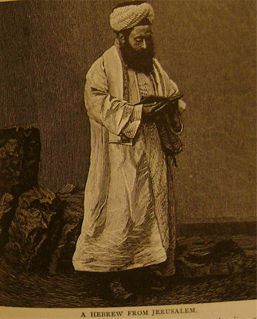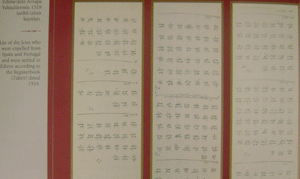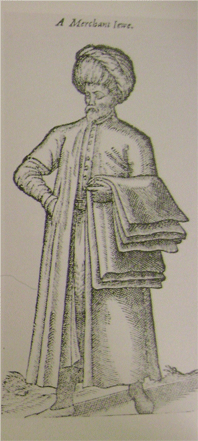| Ottoman Jews in the Context of Geographical Distribution, Population & Housing |
| Monday, 05 October 2009 | |
 By Assistant Prof.Göknur Akçadağ* “…dwell in the best of the land, each beneath his wine and his fig tree, with silver and with gold, with wealth and with cattle…”. A letter – original held at National Bibliothek in Paris – sent by Rabbi Yitzhak Sarfati who migrated to Turkey in the first part of 15th century to Jewish communities in Germany and Hungary inviting his co-religionists to leave the torments they were enduring in Christendom and to seek safety and prosperity in Turkey. His few words in his letter tell us a lot. For 300 years following the expulsion, the prosperity and creativity of the Ottoman Jews rivaled that of the Golden Age of Spain. After 1492 and the edict of Alhambra which forced Jews to choose between leaving Spain or converting to Christianity, the Ottoman Empire – especially cities like Istanbul or Salonika – became one of the main place of refuges for these Iberian Jews but also for Jewish from Central Europe who fled the anti-Jewish politics. At the other chronological extremity, during the Second World War, Turkey would greet an important number of Jewish people who fled Western Europe. So, there is a particular link between the history of the Ottoman Empire and then the Turkish Republic and the history of the Jewish Diaspora.The Jews, lived under the rule of Christianity for three centuries, began to break up after the peninsula was taken away from the Islamic Rule which had conquered and dominated it for three and half centuries. After 1095 the Jews were begging fearfully for protection as the German Jews suffered from oppression, converting to Christianity and being killed. The Jews were massacred by the Crusaders in Germany and Hungary. The first comers from Europe were the Ashkenazi who came from France (1394 Exile), Hungary (1376), Sicily and Italy. The biggest Jewish exile to the Ottoman Empire was the Sephardim exiled from Spain in 15th Century. The Jews were living in the land of two big countries in the 16th and 17th centuries: The Kingdom of Poland and Ottoman Empire. Additionally there were three Jewish groups, namely, the Jews community speaking Farsi in Iran, the Jews speaking Arabic in a land from Iraq to Morocco and old Jewish communities from the Byzantine Period speaking Turkish or Greek. But they were eclipsed by the old Jewish communities arrived by migrations. In the beginning of Ottoman conquests they were the Italian Jews under the Italian Merchant Unions and those settled in the Balkans. The Jewish minority in Salonika had existed there before those migrated from Spain. The Jews had been living in Anatolia and Rumelia since the Roman Empire. But thanks to the encouragement of freedom granted by Mehmet II to the non-Muslim subjects the Jews from Western Europe and Austria came to the Ottoman land, too. As is seen the Jewish migration to the Ottoman Empire did not start in 1492. The origins of those migrated were not only Spain. Most of the Jews came were from Spain though some migrated from Italy and Central Europe, which were under the rule of Spain. The Sephardim Ottoman Jews migrated from Spain and Mediterranean was the community that spread in the largest area geographically in the Ottoman land. They were in Arabian provinces, Maghreb, Egypt, Tripoli, Yemen, Syria, Lebanon, Palestine as well as Mesopotamia, Southeastern Anatolia, Central Anatolia and almost in all city centers in Western Anatolia. They were living in Izmir as a big community. It was even possible to see the Jews Community in the Balkans, Edirne, Salonika, Gallipoli, Bosnia, Southern Bulgaria and Macedonia. For example the number of Jews living in Balat in 1477 was about 7200 according to the census carried out after the conquest of Istanbul. F. Babinger states that it is impossible to compare the conditions of Ottoman Jews with the Jews living in the West in every respect. (Franz Babinger, Mehmet Der Eroberer und Seine Zeit, München 1959, p.109) What the Jewish suffered caused them to act with solidarity with the Turks. There was an example witnessed in 1480 during the Rhodes Siege. While the siege was going on and extending in difficulty the Ottoman Army banded their troops in the Jewish quarters and started to act. The Ottoman troops organized their siege and fights according to the locations of Jews. The Jews, who dreaded of the religious oppressions and persecutions, wished the Ottomans to conquer the Rhodes but this did not come true. Therefore the Jews continued to live there under the same difficulties. (Johannes Adelpus, Die Geschicte von Rhodis, Strazburg 1513, p.35) When the decree enacted regarding the deportation of the Jews in Castilian and Aragon this affected approximately 200 thousand Jews, about 50 thousand of them baptized. First 100 thousand of them took refuge in Portugal. About the 50 thousand migrated from Almeria to Northern Africa and later finding another way to Italy and Ottoman Empire from Valencia and Barcelona. 50 years later nuevos cristianos- Marranos-Conversos, that is those who converted, migrated from Portugal. Most of them went to the Ottoman land. Among the cities they went Salonika especially became an attraction centre and there was a Portugal colony in the late 16th century. Among the Morranos migrated two important figures could gain political power: Yosef Nasi, who converted again to Judaism in Istanbul, became one of the leading diplomats of Babı Ali (Ottoman Government). He was appointed as the Naksos Duke by the Ottoman Sultan. Alvaro Mendes was appointed as the Midilli Duke. (Eva Groepler, Jews in Islam and Ottoman World, Istanbul 1999, p. 24) Baron de Busbecq, who travelled in the Ottoman land, narrates in his travel book (The Life and Letters, London 1881, p.86) “There was a janissary troop in every administration unit of the Empire having a certain population protecting the Christians, the Jews and other unsheltered people from attacks and insults”. With the celebrations in 1992 for the 500th anniversary the ceremonies for arrival of Jews to Turkey were performed very widely as the largest community could find a lasting shelter and a new home herein. They were the grandchildren of those went to the Islamic countries and especially to the big lands of Ottoman Empire in Europe, Asia and Africa. They were the grandchildren of those who accepted the Jews. So therefore they were celebrating the occasion. The Jews chose an Islamic country on purpose. Defecting to Christianity in any Christian country and converting again to Judaism meant to be sentenced to death. But according to the Islamic law the people has a right to choose his religion and convert. In 1555-56 a group of Jews in Ancona subject to the Pontificate were accused as “being marrano” and stood trial. Finally those who quitted Judaism were sentenced to hard labor for life. 24 men and 1 woman were strangled to death by the authorities. Though the Ottoman Sultan carried out an intensive diplomatic attempt he could not ensure them to be freed. (Attilio Nilano, Storia Delgi Ebrei in İtalia, Torino 1963, p.250-252; B.Lewis, Cultures in Conflicts Christians, Muslims and Jews, in the Discovery, Oxford London 1995, p. 23,25) JEWS FROM ISTANBUL TO DIYARBAKIR, BUDAPEST TO JERUSALEM There was a “Yahudiyan” District in Diyarbakir according to the 18-19th century registers. There were also co-districts where they lived together with the Muslims. (Diyarbakir Kadı Registers, Nu.352, p.91; Kemal Karpat, Ottoman Population 1830-1914, p.132). There were about 80 families in 1804. Their number decreased as they migrated to the cities such as Istanbul, Baghdad and Aleppo. Their number was reported to be 1170 in the second half of this century. (BOA, Yıldız Tasnifi, Section 18, doc.: 553/45, box:33). Buckingam, who visited Diyarbakir, writes that there were just a few Jews in 1815 and they migrated to other cities. (J. S. Buckingam, Travels in Mesopotamia, London 1827, p.213). According to the findings of P. Dumont there were 7000 Jews in Silivri during the years of Second Constitutionalist Period (II. Meşrutiyet). (Paul Dumont, “Jewish Communities in Turkey During The Last Decades in the Nineteen Century in the Light of Archives of the Alliance İsraelite Universelle”, Christians and Jews in The Ottoman Empire, (ed. B.Lewis- B.Braude), New York 1982, p.217). B.Lewis gives some important information related to the existence of Sephardim Jews in Budapest. He states that the Hebrew inscriptions he saw in the Buda Castle were the writing style of the Ottoman Sephardim Jews. The Ottoman archives belong to that period proves that the Ottoman Empire settled some Jews from its land after it conquered some parts of Hungary in the early 16th century. It took its Jewish subject back when it left this area in 1686. There are some Sultan firmans (decrees) concerning protection and settlement of Jews in new places in the Ottoman Land. (B.Lewis, p.25). There are some documents suggesting the existence of the Jews in Bursa before the Turkish conquest. Orhan Gazi brought his people from the neighboring countries to develop Bursa. The Jews, who disliked the Byzantine rule, settled in Bursa and constructed a synagogue by the permission of Sultan. Therefore a Jewish district in Bursa appeared. Evliya Çelebi writes in his travel book there were 6 Jewish quarters in the Altıparmak District. (II, p.8). The number of Jewish population and districts increased in Bursa since Bayezid II and Kanuni Süleyman accepted the Jewish people to the Ottoman land. For example, there wasn’t any Jewish in a district in 1487 this number increased to 117 in 1521 and 308 in 1573. It was also possible to determine in which city they had lived before they arrived in another city. For example according to a Tahrir Book register dated 1573 the Kuruçeşme Jews (Baber-Gıruz communities) stayed in Balıkesir before coming to Bursa. They came to Bursa at least 20 years before this date. (Bursa Kadı Register, 100/117, 13a, 113/132, 57a. ). The Jews had an important place in ethnical and religious structure of Bursa and did business extensively with Istanbul Jews. There was a document proving cultural interaction and sharing of the Muslims and Jews. This document tells about that Muslims stopped working and participated in a Jewish Holiday in 6-7 May called (Gül Donanması Holiday) symbolizing the returning of Moses from Mount Tur (Though this document is about a theft occurred as there was no one at home since they were celebrating) . Gaza, Safed and Jerusalem became some cities where the Jews settled after these cities were included in the Ottoman Land. This was one of the reasons affected the growing of the cities. The Ottoman approach to the Jews and Christian communities in Jerusalem was not different from that of to Muslims. Therefore that helped them integrated into Ottoman Empire. One of the evidences of that they applied to the Ottoman Kadi in their judicial matters and asked a verdict according to the Ottoman laws though it was not obligatory to do so. (Dror Ze’evi, An Ottoman Century: The District of Jerusalem in the 1600s, SUNY New York 1996, p. 3-4) 
Ottoman records about Ottoman Jews.
MIGRATIONS AND POPULATIONS OF JEWS AS AN OTTOMAN SUBJECT There are a lot of documents related to the request of the non-Muslim communities to build church, school and their repairs in the Ottoman Archive. In addition the Ottoman Government kept the statistical records of the constructions and repairs carried out after the Reforms Decree (Islahat Fermanı). According to these statistics there are 1 construction decree for Jews, 2 for school construction, 8 for school repair, 8 for reconstruction and repair of church. (ilber Ortaylı, “Eski Türk Şehirlerinde Yapı İşleri”, Economic and Social Progress in Ottoman Empire, Ankara 2000, p.77). According to the census carried out in 1829-1831 the male population was 3.727.738, 15.471 of which were Jewish male population. But several sources suggest that this number is much less than the real population because of some reasons. Therefore a new census was carried out in 1844. According to 1893 census there were in Ottoman provinces 79.727 male-59.975 female Jewish, 22.390 male-21.967 female Jewish in Istanbul, in total 102.118 -81.889 female. There were in grand total 184.007 Jews. In this period the population of rest of the Ottoman Empire was 17.375.225. When the population of some areas and tribes, which were not registered, added to this figure then a figure of 20.475.275 is reached. When 7 million 300 thousand people of Hejaz and Tripoli, excepted from census, and total 11 million 306 thousand people of Egypt, Tunisia, Bulgaria, Cebel-i Lebanon and Cyprus, which were privileged and has self governance, is added then the grand total is calculated as 39.096.294. The Ottoman census data in the Southeastern Europe and Asia provinces, which were subjected to the population exchange in 1906-7, is as follows: (Kemal H. Karpat, Ottoman Population 1830-1914: Demographic and Ethnic Characteristics, Madison 1985, p. 162-169) Muslims: 15.498.747, Rums: 2.823.065, Bulgarians: 761.530, Armenians: 1.031.708, Jews: 253.435. Jews In Istanbul: 47.799, Çatalca: 1766, Edirne: 27.839, Kosova: 1668, Ioannina: 3677, Manastır: 5459, Aydın: 32.521, Trabzon: 299, Jerusalem: 7883 In a general population table prepared for the ethnical and religious communities in the Ottoman Land (Rumelia, Anatolia, Syria, Beirut, Palestine and Zor Sanjak) some 18.520.016 Jews were registered. The total population in this period was 18.520.016, 15.044.846 of which were Muslim. The Jewish population in the sanjaks (districts) according to the 1914 census is as follows: Adana central district: 20, Ceyhan administrative district: 3, Dörtyol district: 3, Mersin central: 35, Tarsus district: 5, Ankara central: 1026, İzmir central: 24.069, Bergama district: 698, Menemen district: 425, Urla district: 423, Çeşme district: 199, Foçateyn district: 83, Kuşadası district: 157, Seferihisar district: 4, Tire district: 1872, Bayındır district: 10, Ödemiş district: 12, Nif (Kemalpaşa) district: 15, Manisa central: 2146, Kasaba (Turgutlu) district: 983, Salihli district: 242, Karaağaç district: 30, Soma district: 11, Akhisar: 471, Aydın c.d: 2560, Nazilli: 463, Bozdoğan: 3, Söke: 95, Çine: 30, Denizli c.d.: 35, Sarayköy: 5, Beyrut c.d: 3431, Sayda: 859, Merciyun (Cedide): 278, Tripoli: 72, Akka: 106, Haifa: 2439, Taberiya: 3194, Safed: 4644, Nablus central: 29, Diyarbakir central: 520, Cizre: 234, Nusaybin: 1009, Siverek central: 136, Çermik: 184, Viranşehir: 2, Edirne c.d: 13889, Mustafa Paşa: 568, Seymenli: 10, Dimetoka: 986, Uzunköprü: 232, Kırkkilise c.d: 987, Lüleburgaz: 434, Baba-yı atik (Babaeski): 48, Tekfurdağı (Tekirdağ) central: 1566, Çorlu: 1211, Saray: 4, Gelibolu central: 2576, Keşan: 1, Eceabat: 3, Erzurum central: 10, Aleppo central: 9973, Iskenderun: 129, İdlib: 53, Antakya: 357, Bilan: 18, Harim: 1, Menbiç: 1, Ayıntap (Antep): 860, Kilis: 775, Rumkale: 26, Bursa c.d: 3687, Karacabey: 44, Mudanya: 53, Kirmasti: 184, Bilecik central: 52, İnegöl: 106, Istanbul central: 13441, Makriköy (Bakırköy): 364, Adalar: 79, Beyoğlu and Boğaziçi (Rumeli coast): 31080, Üsküdar and Boğaziçi (Anadolu coast): 6836, Gebze: 21, Kartal: 31, Beykoz: 292, Sinop c.d: 8, Konya-Akşehir: 1, Ereğli: 3, Amasya-Köprü district: 1, Tokat central: 339, Erbaa: 4, Syria Province-Damascus central: 10.129, Ba’albek: 1, Hasbiya: 6, Kuneytara: 4, Trabzon Province-central: 8, Van Province- Başkale: 836, Şemdinan (Şemdinli): 274. The Jewish population in the districts which were directly under the rule of Central Administration is as follows: Though the the separation movements started among the communities breeding hostility each other in the Ottoman Empire in the 18th century none of them could establish a majority to found a state in a specific region. During these separation movements the Muslims and Jewish were on the one side while the Orthodox Christians were on the opposite side. That the Ottomans started to retreat from the Balkans as of 1877 caused most people to be émigré until 1914. The Jews preferred to live under the rule of Ottoman as there was a risk of discrimination by the Orthodox Christians against them. The Ottoman State settled them in Anatolia bearing their transportation costs. Several Jews were killed in Niş by the Serbians in 1878. The Bulgarians, armed by the Russians, killed the Turks and Jews. . (L.Bernhard, Les Atrocités Russes en Bulgarie et en Arménie Pendant La Guerre de 1877, Berlin 1878, p.29). They were free to migrate to the Ottoman land or Palestine. This explains the existence of Jews in Palestine after 1914. According to Karpat’s findings the Southeastern Europe Region harbored the 25.27% of all the Ottoman Jews. 21.63% settled in Anatolia, 14.61% in Istanbul, 23.88 in Iraq and Palestine as well as about 14.61% in Syria. (Justin McCarty, “Jewish Population in the Late Ottoman Period”, The Jews of the Ottoman Empire, (ed.A. Levi), Princeton 1994, p.395; K.Karpat, “Jewish Population Movement 1862- 1914”, p. 399-521) An important finding of Karpat must be recalled here: Both Jews and Muslims invented their national identity brands, which would unite their migrated people in their motherland, as a reaction to the nationalism mixed with the ethnicized Orthodox belief of the Southeastern Europe dominated by Poland and Russia. Ben Gurion and Itzak Ben Zvi, the real ideologist and nation builders of Jewish nationalism, established their ideological formations not only in Poland but also Turkey. Both of them could speak Turkish. Gurion studied in the Faculty of Law in Turkey. The Jews and Turks experienced the similar historical courses as the Turkish identity was originated from the Ottoman identity and the Jewish nationalism was born out of the Jewish identity. * SUNY- Binghamton University- Fernand Braudel Center former scholar, Yıldız Technical Uni., Department of Humanities and Social Sciences-İstanbul / İnonu Uni. Department of History, Turkey |



Leave a Reply